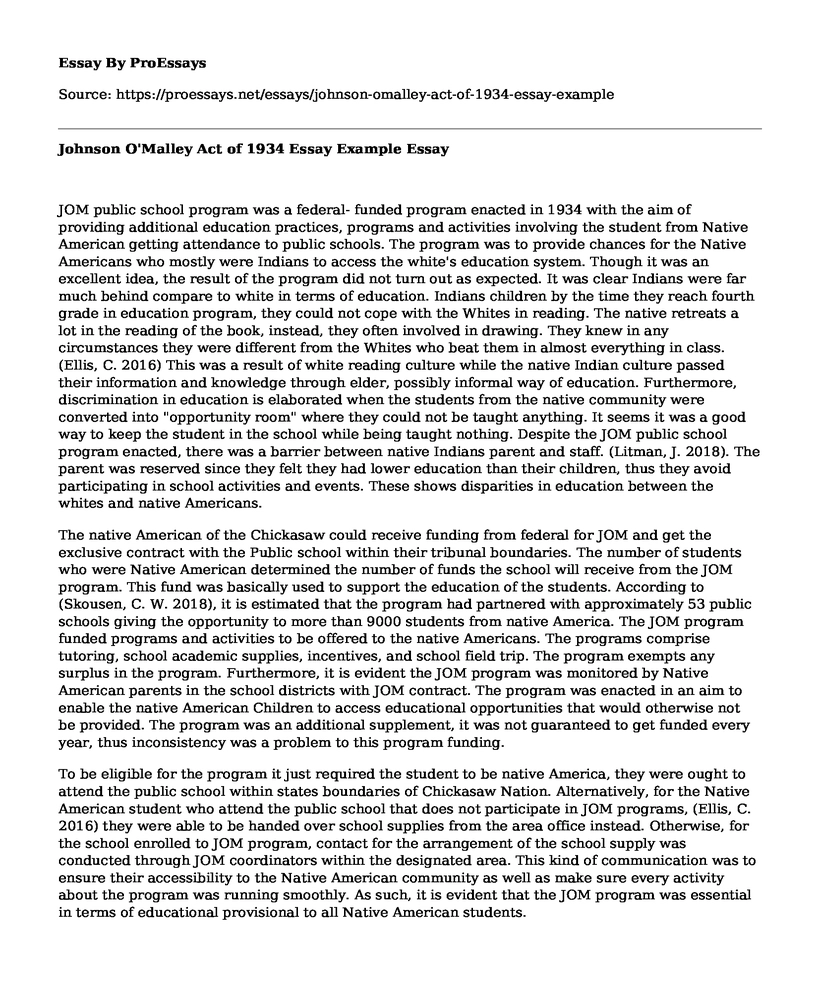JOM public school program was a federal- funded program enacted in 1934 with the aim of providing additional education practices, programs and activities involving the student from Native American getting attendance to public schools. The program was to provide chances for the Native Americans who mostly were Indians to access the white's education system. Though it was an excellent idea, the result of the program did not turn out as expected. It was clear Indians were far much behind compare to white in terms of education. Indians children by the time they reach fourth grade in education program, they could not cope with the Whites in reading. The native retreats a lot in the reading of the book, instead, they often involved in drawing. They knew in any circumstances they were different from the Whites who beat them in almost everything in class. (Ellis, C. 2016) This was a result of white reading culture while the native Indian culture passed their information and knowledge through elder, possibly informal way of education. Furthermore, discrimination in education is elaborated when the students from the native community were converted into "opportunity room" where they could not be taught anything. It seems it was a good way to keep the student in the school while being taught nothing. Despite the JOM public school program enacted, there was a barrier between native Indians parent and staff. (Litman, J. 2018). The parent was reserved since they felt they had lower education than their children, thus they avoid participating in school activities and events. These shows disparities in education between the whites and native Americans.
The native American of the Chickasaw could receive funding from federal for JOM and get the exclusive contract with the Public school within their tribunal boundaries. The number of students who were Native American determined the number of funds the school will receive from the JOM program. This fund was basically used to support the education of the students. According to (Skousen, C. W. 2018), it is estimated that the program had partnered with approximately 53 public schools giving the opportunity to more than 9000 students from native America. The JOM program funded programs and activities to be offered to the native Americans. The programs comprise tutoring, school academic supplies, incentives, and school field trip. The program exempts any surplus in the program. Furthermore, it is evident the JOM program was monitored by Native American parents in the school districts with JOM contract. The program was enacted in an aim to enable the native American Children to access educational opportunities that would otherwise not be provided. The program was an additional supplement, it was not guaranteed to get funded every year, thus inconsistency was a problem to this program funding.
To be eligible for the program it just required the student to be native America, they were ought to attend the public school within states boundaries of Chickasaw Nation. Alternatively, for the Native American student who attend the public school that does not participate in JOM programs, (Ellis, C. 2016) they were able to be handed over school supplies from the area office instead. Otherwise, for the school enrolled to JOM program, contact for the arrangement of the school supply was conducted through JOM coordinators within the designated area. This kind of communication was to ensure their accessibility to the Native American community as well as make sure every activity about the program was running smoothly. As such, it is evident that the JOM program was essential in terms of educational provisional to all Native American students.
References
Litman, J. (2018). What We Don't See When We See Copyright as Property.
Skousen, C. W. (2018). Minding the Gap: Improving Parental Involvement to Bridge Education Gaps Between American Indian and Non-Indian Students. Brigham Young University Education and Law Journal, 2018(2), 101-158.
Ellis, C. (2016). AMERICAN INDIANS AND EDUCATION.
Cite this page
Johnson O'Malley Act of 1934 Essay Example. (2022, Oct 19). Retrieved from https://proessays.net/essays/johnson-omalley-act-of-1934-essay-example
If you are the original author of this essay and no longer wish to have it published on the ProEssays website, please click below to request its removal:
- Personal Essay Example - Achieving Goals Through Cooperation
- Children With Diabetes Have Poor Academic Performance Essay
- Problem Solution Essay on Teacher's Incompetence and Resistance to Technology Integration
- Essay Sample on Developmentally Appropriate Practice
- Applying Critical Thinking in Solving Cloud Computing Problem
- Essay Sample on College Choice: A Symbolic Figure in Career Development
- Research Paper Example on Innovate & Entrepreneur: The Keys To Success In A Competitive Market







